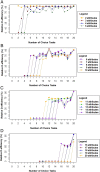Simulation study to determine the impact of different design features on design efficiency in discrete choice experiments
- PMID: 27436671
- PMCID: PMC4964187
- DOI: 10.1136/bmjopen-2016-011985
Simulation study to determine the impact of different design features on design efficiency in discrete choice experiments
Abstract
Objectives: Discrete choice experiments (DCEs) are routinely used to elicit patient preferences to improve health outcomes and healthcare services. While many fractional factorial designs can be created, some are more statistically optimal than others. The objective of this simulation study was to investigate how varying the number of (1) attributes, (2) levels within attributes, (3) alternatives and (4) choice tasks per survey will improve or compromise the statistical efficiency of an experimental design.
Design and methods: A total of 3204 DCE designs were created to assess how relative design efficiency (d-efficiency) is influenced by varying the number of choice tasks (2-20), alternatives (2-5), attributes (2-20) and attribute levels (2-5) of a design. Choice tasks were created by randomly allocating attribute and attribute level combinations into alternatives.
Outcome: Relative d-efficiency was used to measure the optimality of each DCE design.
Results: DCE design complexity influenced statistical efficiency. Across all designs, relative d-efficiency decreased as the number of attributes and attribute levels increased. It increased for designs with more alternatives. Lastly, relative d-efficiency converges as the number of choice tasks increases, where convergence may not be at 100% statistical optimality.
Conclusions: Achieving 100% d-efficiency is heavily dependent on the number of attributes, attribute levels, choice tasks and alternatives. Further exploration of overlaps and block sizes are needed. This study's results are widely applicable for researchers interested in creating optimal DCE designs to elicit individual preferences on health services, programmes, policies and products.
Keywords: conjoint analysis; design efficiency; discrete choice experiment; patient preferences.
Published by the BMJ Publishing Group Limited. For permission to use (where not already granted under a licence) please go to http://www.bmj.com/company/products-services/rights-and-licensing/
Figures



References
Publication types
MeSH terms
LinkOut - more resources
Full Text Sources
Other Literature Sources
